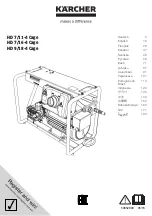
- 6 -
English
Examples of unreasonable use:
-
Washing surfaces not suitable for cleaning with a high
pressure jet.
-
Washing people, animals, electric equipment or the machi-
ne itself.
-
Using unsuitable detergents or chemicals.
-
Blocking the trigger (lever) of the lance in “ON” position.
The manufacturer cannot be held responsible for any damage
due to improper, incorrect or unreasonable use. As far as safety
rules are concerned, the cleaners are manufactured according
to the European Standard.
When buying your cleaner, ensure that it has an identi-
fication plate. If there is no plate, inform the manufacturer
and/or the dealer immediately. Machines without a plate
must not be used and the manufacturer declines all re-
sponsibility for them. Products without a plate must be
considered anonymous and potentially dangerous.
PRELIMINARY OPERATIONS
UNPACKING
After unpacking, ensure that the cleaner is undamaged.
If in doubt, do not use the machine.
Contact your dealer.
Packaging (bags, boxes, nails, etc) is potentially dangerous and
should be kept out of reach of children. It should be disposed of
or retained in respect of national environmental legislation.
FITTING THE SEPARATE PARTS OF THE MACHINE
All the fundamental parts and safety devices of the machine are
assembled by the manufacturer.
for reasons of packing and transport, some secondary cleaner
parts are supplied separately.
The user must fit these parts as explained in the instructions
supplied in each assembly kit.
DATA PLATE:
The data plate bearing the
main technical characteristics
of your cleaner is located on
the frame and is always visible
(fig. 1).
COMMAND AND CONTROL DEVICES
Before connecting the machine to the water supply and
to the power mains, it is essential to know the function of the
cleaner's command and control devices.
fIG. 1
fIG. 3
fIG. 2
FILLING THE DETERGENT
TANK
from the range of recommen-
ded products, choose the one
most suited to the washing job
to be done (fig. 2) and dilute
it with water according to the
instructions on the pack.
fill the detergent tank with the
diluted product (fig. 3).
Ask your dealer for the cata-
logue of the detergents that
can be used depending on
the type of washing job to be
done and the type of surface
to be treated.
After using a detergent, the
detergent intake circuit must
be flushed out with clean water
(fig. 8).
!
!
Chemical
Chemical







































